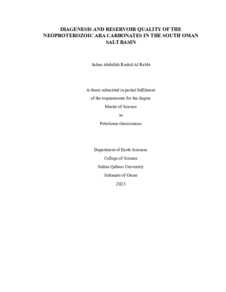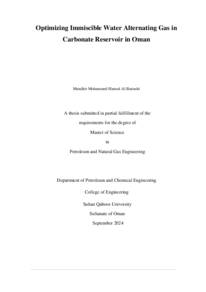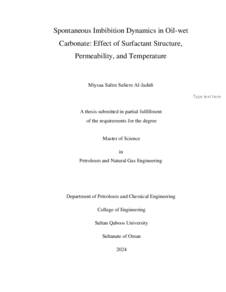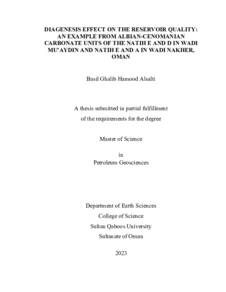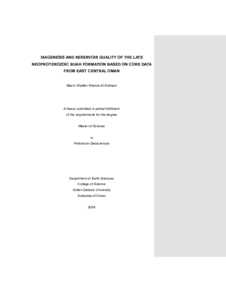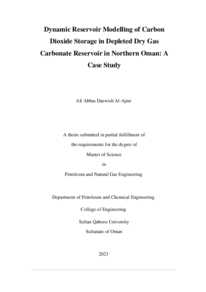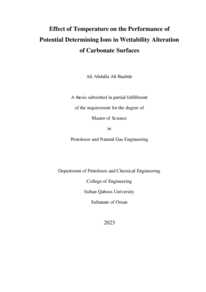Document
Diagenesis and reservoir quality of the Neoproterozoic Ara carbonates in the South Oman Salt Basin.
Source
Master's thesis
Other titles
التغيرات اللاحقة وجودة الخزانات الكربوناتية لحقبة ي النيوبرتيرويك لمجموعة آرا في الحوض الملحي الجنوبي لسلطنة عمان
Country
Oman
City
Muscat
Publisher
Sultan Qaboos University
Gregorian
2023
Language
English
Thesis Type
Master's thesis
English abstract
Intra-salt carbonate stringers are distributed in different basins around the world and play
a significant role as source rock, reservoir, and seal in the petroleum systems of these
basins. The Ara intra-salt carbonates are one of the most important petroleum systems in
the Interior Oman Salt Basins. The Intra-salt carbonate stringers belong to the Ara Group
composed of six, third-order cycles of evaporites and carbonates. The intra-salt carbonate
stringers reservoir lithofacies are microbial laminate, different types of grainstones, and
thrombolitic boundstone. The main risk facing the hydrocarbon production from the
stringers of the Ara carbonates is the pore-filling halite cement in some areas of the South
Oman Salt Basin (SOSB). Understanding the diagenetic effect is essential to predict the
reservoir quality. This study aims to improve the understanding of the diagenesis and
reservoir quality of the Ara carbonates in the Birba and Harweel clusters.
This study is based on subsurface data from five wells, B in the Birba Cluster and D1, D2,
M, and R in the Harweel Cluster. Fifty-three blue epoxy-impregnated and stained thin
sections were described under microscopy. The diagenesis alterations and porosity were
quantified using the point counting technique by counting 500 points in each thin section.
Ten representative samples from the Harweel Cluster were analyzed under scanning
electron microscopy and energy-dispersive X-ray analysis to study the paragenetic
sequence, porosity, and chemical composition of the grains. The X-ray diffraction method
was applied to 10 samples to estimate their mineralogy. The inductive coupled plasma
optical emission spectroscopy was done on 7 samples from halite and anhydrite
cementations to analyze their chemical compositions. The porosity and permeability were
studied using fifty-three thin sections, SEM analysis on ten samples, core porosity, and
permeability measurements from 308 samples, and wireline logging data from the five
wells.
Ara carbonates in the Birba and Harweel clusters were affected but in different amounts
by diagenetic processes. For instance, micritization, dolomitization, replacement of
dolomite by evaporitic minerals, pore and fracture-filling halite, anhydrite, and solid
bitumen, silicification, pyritization, several dissolution events, mechanical and chemical
compactions, and two generations of fractures (opened and cemented fractures).
Additional authigenic minerals were found only in the samples of the Harweel Cluster,
including phosphorus-rich carbonate, strontianite, and illite. The number of replacive
evaporites, and cementation by halite, anhydrite, and solid bitumen, as well as
silicification, was more in the Harweel than in the Birba Cluster. The reservoirs in the
Birba Cluster have a better reservoir quality than the Ara carbonate reservoirs in the
Harweel Cluster in which their pore spaces are not strongly plugged with halite, anhydrite,
and solid bitumen. Among the lithofacies associations in the Harweel Cluster, the
vii
intertidal, and slope basin lithofacies associations are characterized by higher porosity
than the rest of the lithofacies associations. The lithofacies with lower porosity values in
the Harweel Cluster, including shallow subtidal, open marine thrombolites, shoal, and
offshore transition zone lithofacies association are affected mostly by the pore-filling
halite (most dominant), anhydrite, and solid bitumen which in turn reduce their reservoir
quality.
Category
Theses and Dissertations

